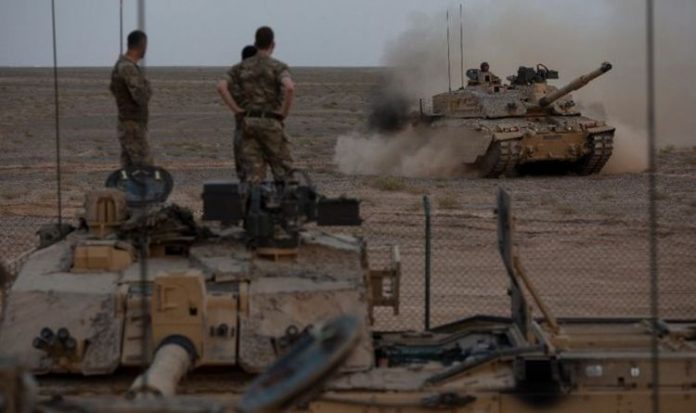Gen Sir Richard Barrons, who retired in 2016, said that, while armour will continue to play a role, advances in missile technology and Britain’s failure to invest in air defence means that the days of the Main Battle Tank main are over.
“The Army is in third place behind the needs of the Royal Navy and RAF right now. Our carriers, F-35s, surveillance aircraft and UAVs all have a higher priority than a having a big Continental-facing army that is no longer on the Continent,” he said last night.
“Why invest in something which will be destroyed before it has driven ten yards?”
A move to rely less on “heavy metal” is already an integral part of Army 2020 Refine doctrine, which will see greater reliance placed on information, cyber and electronic operations.
But the plan, based on two revolutionary strike brigades, does rely on two armoured regiments – both equipped with the 40-year-old tanks.
In 2015 General Sir Nick Carter, now Chief of the Defence Staff, announced the Challenger would be upgraded and last year the MoD announced a contract to refurbish all 227 tanks left in service at a cost of £400 million to replace engines and the gearbox.
And now a desire to put a new smooth bore gun on the Challenger – years after Germany made similar changes to its Leopard 2 main battle tank – and a new fire control system has boosted capacity the project costs to £1.5 billion to ensure it can support its future role in the two armoured brigades.
Despite not being used in anger since the Gulf War in 1991, where desert conditions were ideal for traditional tank warfare, the Challenger still plays an active role.
This weekend they are deployed just miles away from the Russian border in Georgia as part of Noble Partner, a joint exercise with the US, Poland and Georgia, while Challengers are also based in Estonia as part of Britain’s Commitment to protect Baltic nations. At Christmas they are expected to take part on desert war games in Oman.
But Gen Carter, who spearheaded the creation of 77 Brigade – the Army’s so called social media force – and the formation of a specialist new 13 Signals regiment, has already made it clear to ministers that, if he doesn’t receive a firm commitment to fund the Challenger and Warrior upgrades in November, they will be either scrapped or mothballed.
Senior officers at Bovington Garrison, home to both the Royal Armoured Corps and the Royal Tank Regiment, are resigned to their fate, however, acknowledging the CDS might have little sway in what is ultimately a political decision. Some even believe the move, which May affect up to 8,000 service personnel, is part of a broader strategy to reduce overall British Army numbers to a rumoured 70,000 target.
But last night Gen Barrons said axing Challenger would liberate the British Army, rather than impede it.
“Over the last twenty years technology has marched on,” he said.
“The battlefield has become transparent due to advances in satellite, UAVs, aircraft or radar and the ability that we once had to move a big armoured formation with some secrecy has all but gone.
“And improvements in missile technology mean the tank is far more vulnerable than it was. Short range anti-tank missiles are very effective up to five km, and very long range with missiles with cluster bombs can knock out lightly armoured supporting vehicles. The British Army has virtually no air and missile defence now.
“In the Ukraine, two battalion of Ukrainian mechanised infantry were spotted by drones and destroyed by long range Russian artillery in 15 minutes.
“The UK battle group in Estonia is as vulnerable, because it cannot shoot down the drone or deal with long range Russian artillery.
“Bringing the British army’s current structure into the 21st century without investing in air defence, network capability and a manned /unmanned /autonomous path means investing in obsolescence.”
He said armour would still play a vital role.
The Ministry of Defence has ordered 589 Ajax fast reconnaissance tanks at a cost of £6.5 Billion which will be split across four regiments supported by A £1 billion Warrior Sustainment Programme to upgrade an existing armoured vehicle.
Both projects are behind schedule with the Ajax project currently a year delayed and the Warrior two years — leaving the Army’s future plans in chaos as Downing Street seeks to cut spending in its Integrated Defence and Security Review.
“You still need to be able to fight an armour force to keep what you want to keep or seize what you want to seize, he said.
“A Challenger weighs 70 tonnes. What we need is something that is nimble, very protected and is missile based.”
He said other Nato members were having exactly the same debate.
“We are good enough to see what transformation may look like,” he said.
“If the UK chose to go down this transformative path – developing better air defence, long range precision missiles, different unmanned and autonomous capabilities all networked and made cyber resilient – and offer it to Nato it would set the example so be good for British influence.
“And it will be good for the British defence industry, too. “







